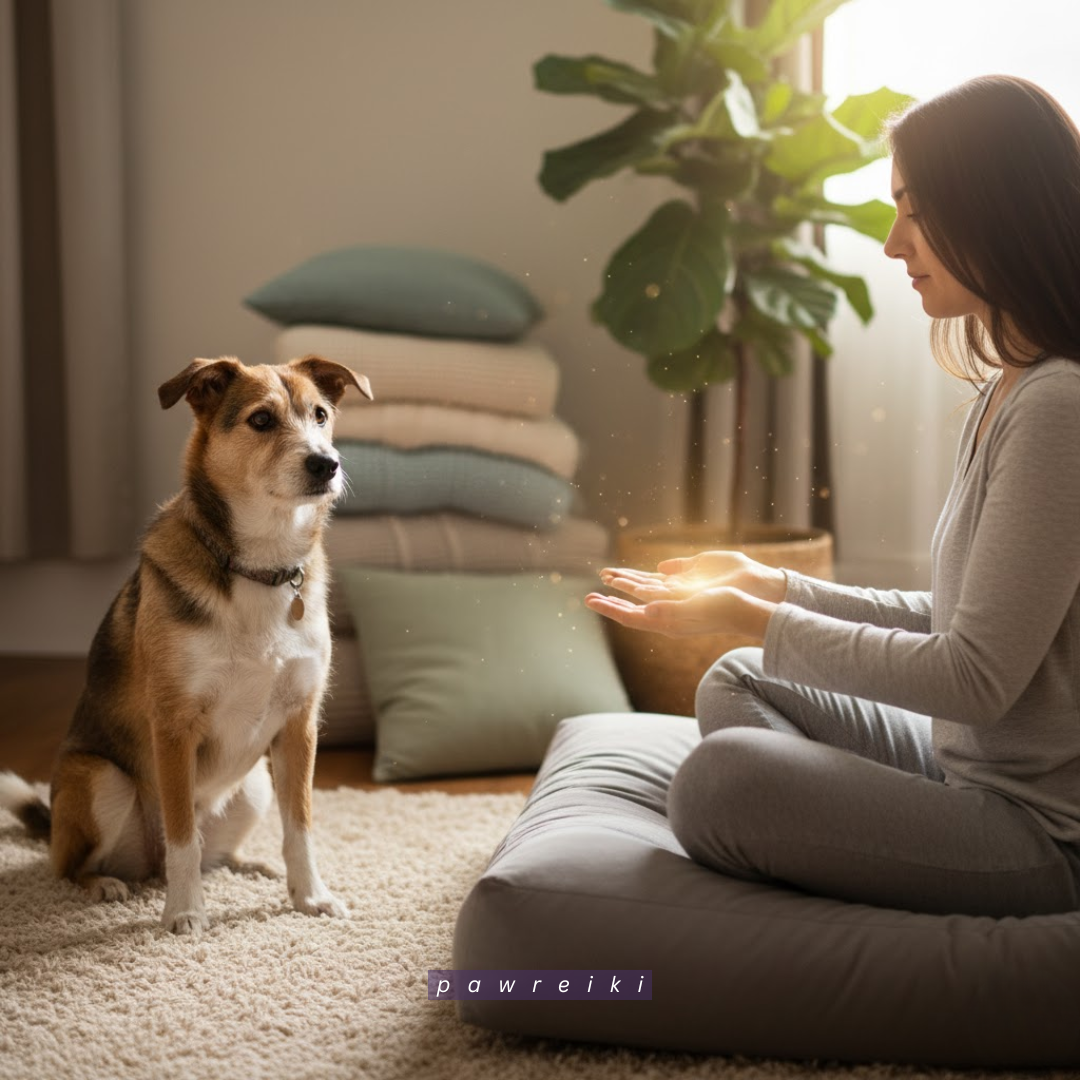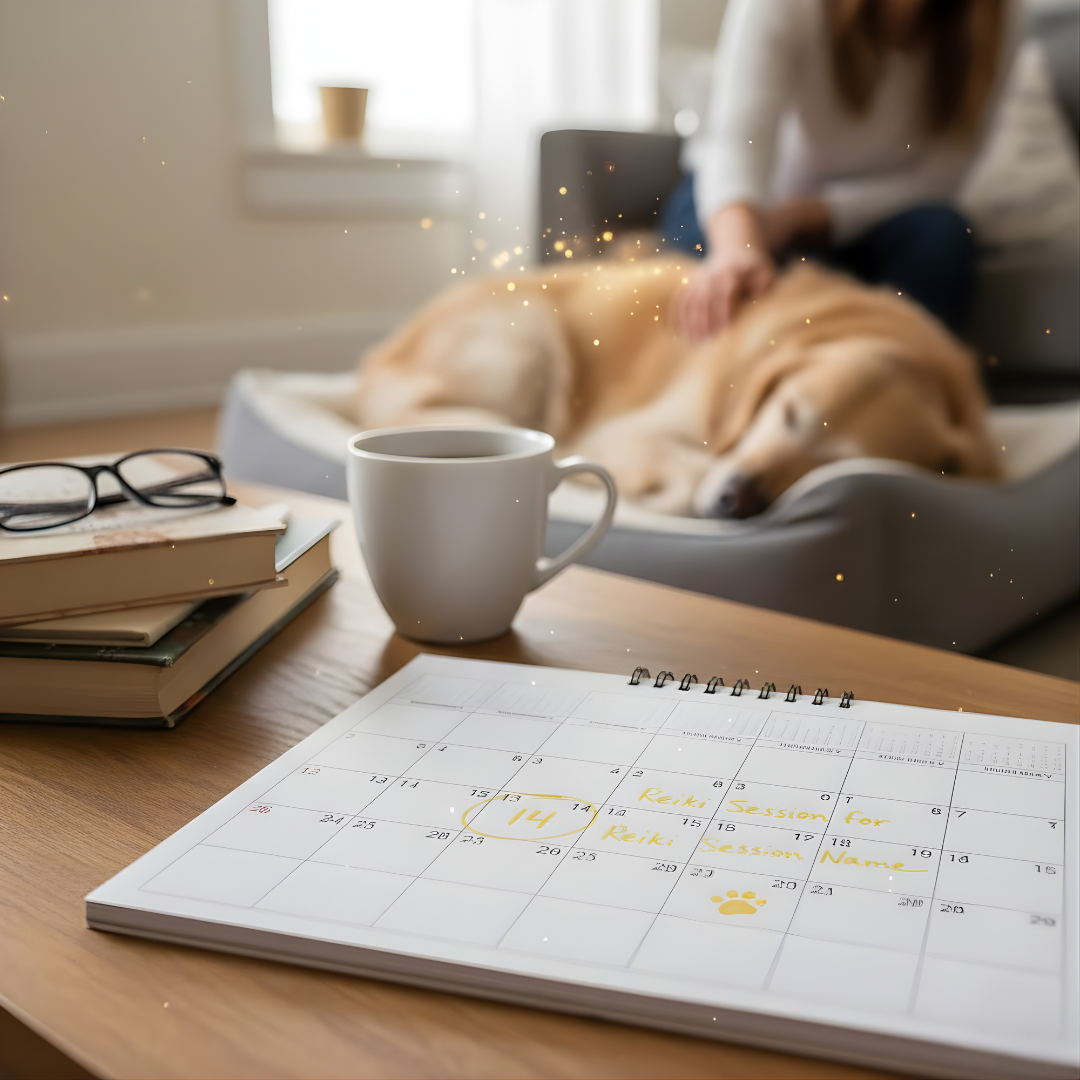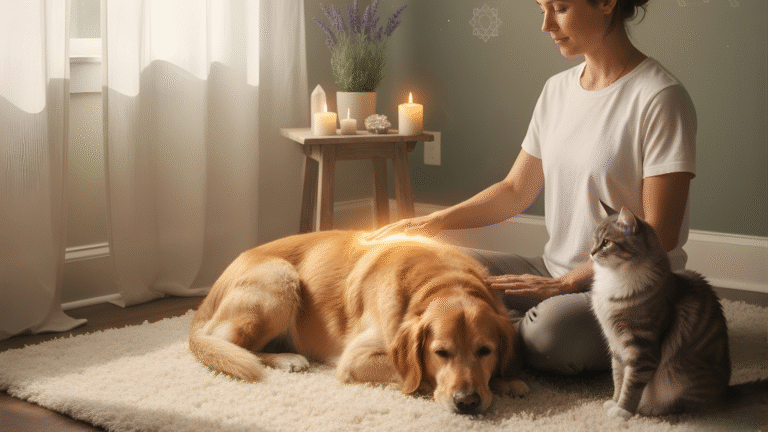Reiki and Dogs: A Gentle Path to Healing and Calm
“Reiki is not simply energy work—it’s communication. Dogs understand it as a silent language of compassion, connection, and care.”— Mia Jordan, Animal Behaviour Specialist..
Reiki and Dogs is a gentle, non-invasive energy healing method that promotes emotional balance, physical comfort, and a more profound human–animal connection.
Dogs naturally respond to Reiki because they are susceptible to human intentions and subtle energy. Whether your dog struggles with anxiety, trauma, or physical discomfort, Reiki offers peaceful, supportive care.
This guide explains a complete step-by-step process so you can confidently use Reiki to calm your dog and strengthen your bond.
Why Reiki Is Important For Dogs
1. Emotional Sensitivity
Dogs are naturally emotional beings who quickly absorb the energy around them, including fear, stress, or tension. Reiki helps release these negative energies and restores emotional balance.
By calming the nervous system, Reiki reduces anxiety, fear, and overwhelm, allowing dogs to feel safe, supported, and emotionally grounded in their environment.
2. Physical Comfort And Healing
Reiki promotes deep relaxation that activates the body’s natural healing abilities. It eases muscle tension, reduces stiffness, and supports recovery from injuries or age-related discomfort.
The mild, vigorous flow enhances comfort, mobility, and general physical well-being, making everyday tasks more straightforward and more pleasurable for older dogs in particular.
3. Strengthens Bond With Owner
Reiki sessions create a peaceful shared space where both the dog and the owner connect through calm, loving energy. This enhances trust and strengthens emotional communication.
Over time, dogs associate their owner with safety, comfort, and healing, deepening the bond and building a long-term relationship based on mutual understanding and affection.
4. Holistic And Drug-Free Approach
Reiki offers a natural, medication-free way to support a dog’s emotional and physical health. It complements traditional treatments without causing side effects.
This gentle approach helps reduce stress, balance energy, and promote overall wellness. For sensitive or older dogs, Reiki provides a safe, non-invasive method of healing and emotional support.
5. Reduces Anxiety And Stress
Reiki creates an atmosphere of calm that helps anxious, fearful, or overexcited dogs relax. By balancing their internal energy, it gently releases accumulated stress and tension.
This leads to improved emotional stability, better sleep, and a more confident demeanour, helping dogs cope more easily with everyday triggers and challenges.

Step-By-Step Healing Process For Calm And Connection
Step 1: Create A Calm Space
A peaceful environment sets the foundation for effective Reiki healing. Choose a quiet, familiar place where your dog naturally feels safe—such as their bed, a soft blanket, or a quiet corner of your home.
Dim lighting, soft music, or gentle nature sounds can support relaxation, but keep everything subtle. Remove distractions, loud noises, and unnecessary movements around the area.
Allow your dog to explore and settle freely without interference. When your dog senses calm surroundings, their nervous system relaxes and becomes more receptive to energy work. A steady, quiet space builds trust and prepares them for healing.
Key Points
- Calm space creates emotional safety
- Familiar areas reduce stress
- Soft sounds increase relaxation
Pro Tip
Use one or two drops of pet-safe lavender to create a soothing environment. A gentle aroma helps your dog settle emotionally and prepares them to receive Reiki comfortably.
Step 2: Centre Your Own Energy
Before beginning Reiki, take a moment to ground and settle your own energy. Dogs absorb human emotions instantly, so your inner calm directly impacts their comfort. Sit in a relaxed position, close your eyes, and take slow, deep breaths to quiet mental chatter.
With each exhale, imagine releasing tension, and with each inhale, visualize peaceful, warm energy filling your body. Allow your mind to soften and your heartbeat to slow.
This centred state creates a stable channel for Reiki to flow smoothly. When your energy is balanced, your dog feels safe, supported, and naturally begins to relax around you.
Key Points
- A calm mindset improves energy flow
- Dogs mirror your emotional state
- Grounding builds trust
Pro Tip
Breathe deeply for 30–40 seconds and imagine stress melting away. A grounded practitioner helps the dog feel secure and enhances overall Reiki effectiveness.
Step 3: Set A Clear Intention
Reiki becomes more powerful and effective when guided by a clear, meaningful intention. Before placing your hands on your dog, pause and silently express the type of energy you wish to offer—calmness, emotional healing, comfort, or gentle relief from tension.
Intention doesn’t force results; it simply guides the energy to flow naturally where it is needed most. Keep your intention simple, sincere, and from the heart rather than complicated or demanding.
Dogs sense emotional authenticity deeply, and your focused intention helps them feel safe and reassured. This mental clarity strengthens your energetic connection, allowing Reiki to flow more harmoniously throughout the session.
Key Points
- Clear intention guides healing
- Emotion-led focus works best
- Helps energy flow smoothly
Pro Tip
Focus on one heartfelt intention, like “peace for my dog.” A single, warm intention strengthens energy flow and helps your dog relax and receive Reiki more easily.
Step 4: Invite Your Dog To Join
Offering Reiki should always be gentle and never coerced. Let your dog approach you at their own speed as you sit quietly in a peaceful area. Many dogs will sniff your hands, circle nearby, or sit a short distance away, assessing your energy before engaging.
Avoid calling or physically guiding them closer; remain relaxed and patient. Even if your dog walks away initially, they often return once they sense the soft, healing energy.
Offering a complete choice builds trust, reduces resistance, and ensures the session is comfortable, safe, and inviting. This respectful approach forms the foundation for a positive Reiki experience.
Key Points
- Consent increases trust
- Free movement reduces stress
- Voluntary engagement deepens healing
Pro Tip
Repeat your intention silently three times. Keep it simple and positive to create a clear, energetic pathway that your dog can easily recognize, receive, and respond to naturally.

Step 5: Begin With Hands-Off Energy
Start your Reiki session by channelling energy from a short distance instead of touching your dog right away. Hold your hands about two to three inches above their body, typically near the head, shoulders, or upper back.
This gentle, hands-off introduction allows sensitive or anxious dogs to adjust to the energy gradually. Observe their reactions closely—slower breathing, softened eyes, relaxed ears, or lying down are signs of comfort and acceptance.
This approach creates a soft, energetic bubble that feels safe and non-intrusive. By beginning this way, you prepare your dog emotionally and physically for more profound healing as the session progresses.
Key Points
- Gentle start builds comfort
- Hands-off works for sensitive dogs
- Encourages natural acceptance
Pro Tip
Move your hands slowly above your dog to keep the energy gentle and safe. This soft approach helps anxious dogs relax and prepares them for smoother hands-on healing.
Step 6: Shift To Gentle Touch
Once your dog shows clear signs of comfort—such as settling beside you, softening their posture, or breathing more slowly—you can transition to gentle hand placement.
Rest your hands lightly on areas like the shoulders, chest, or back, keeping your touch soft and steady. Avoid pressing or massaging, as Reiki and Dogs work best through calm stillness rather than physical pressure.
Watch your dog’s signals closely: leaning in or sighing indicates comfort, while shifting away means you should ease your touch or return to hands-off energy. This gentle contact grounds your dog, strengthens trust, and supports smoother, deeper energetic flow.
Key Points
- Light touch supports grounding
- Body language guides placement
- Touch builds emotional safety
Pro Tip
Warm your hands beforehand so the first touch feels comforting. A warm, steady hand helps your dog feel secure and encourages them to accept deeper energy flow.
Step 7: Work On The Heart Area
The heart is the emotional center for dogs, especially those dealing with anxiety, insecurity, or past stress. Gently place your hands over your dog’s chest and maintain slow, steady breathing to create a calm, energetic flow.
This placement helps balance emotional energy and encourages feelings of safety, affection, and reassurance. Many dogs respond by leaning into your hands, closing their eyes, or taking deep, soothing breaths.
The heart chakra is key for emotional release, allowing your dog to let go of stored tension. Spending extra time here builds a powerful emotional connection, strengthens trust, and deepens the bond between you.
Key Points
- Heart work reduces anxiety
- Encourages emotional release
- Builds a deeper connection
Pro Tip
Visualize soft green light flowing into your dog’s heart area. Green energy promotes emotional healing, strengthens safety, and builds a more profound sense of connection during the session.
Want to Share Your Love for Pet Reiki?
Discover how rewarding it can be to bring healing energy and compassion to pets — and to share that passion online with others.
Step 8: Scan For Energy Imbalances
Energy scanning helps you identify areas where your dog needs additional support. Move your hands slowly above your dog’s body, from head to tail, paying close attention to subtle sensations such as warmth, coolness, tingling, or heaviness. These energetic cues often indicate emotional tension or physical discomfort.
Keep your movements slow, steady, and patient so you don’t miss delicate signals. Many dogs will shift position or gently present certain areas, guiding you toward where healing is needed most.
This scanning process personalizes the Reiki session, ensuring that energy flows directly to the places that require deeper attention and care.
Key Points
- Reveals tension areas
- Improves energy accuracy
- Follows the dog's signals
Pro Tip
Close your eyes briefly while scanning to feel subtle temperature shifts more clearly. This increases sensitivity and helps you detect areas needing extra attention.
Step 9: Balance The Chakras
Dogs have chakra centers similar to humans, each connected to emotional stability and physical well-being. Gently spend a few moments on each chakra—from the crown at the head to the root near the tail—allowing energy to flow smoothly through the entire system.
When chakras are balanced, dogs experience reduced stress, improved confidence, and greater emotional clarity. You may notice signs of deep relaxation, such as stretching, sighing, or settling into a calmer posture.
Chakra balancing creates overall energetic harmony, helping your dog feel grounded, secure, and centred. This step supports long-term emotional balance that continues well beyond the session.
Key Points
- Supports emotional alignment
- Encourages calm behaviour.
- Strengthens energetic harmony
Pro Tip
Imagine golden light moving through each chakra. This visualization strengthens energetic balance, helping your dog release stress and settle into a calmer emotional state.
Step 10: Focus On Problem Areas
If your dog experiences pain, stiffness, digestive discomfort, or emotional triggers, spend extra time focusing on those areas. Place your hands gently and allow Reiki energy to flow naturally, without forcing or pressing.
Pay attention to your dog’s body language—shifting closer or presenting a specific spot indicates where attention is needed most.
Targeted energy helps relieve physical discomfort and encourages emotional release. Reiki complements the body’s natural healing processes and supports well-being alongside veterinary care.
By addressing these specific needs, the session becomes more personalized, meaningful, and practical, helping your dog feel calmer, safer, and more balanced overall.
Key Points
- Helps ease discomfort
- Personalized healing
- Supports natural recovery
Pro Tip
If your dog shifts closer or presents a specific body part, spend extra time there. Dogs guide healing naturally, helping you focus energy exactly where it’s needed.

Step 11: Observe Behavioural Responses
A dog’s body language provides vital guidance during Reiki sessions. Yawning, stretching, licking lips, snuggling closer, or lying down are all signs of relaxation and energy release.
Occasional shaking often indicates your dog is processing energy rather than feeling discomfort. Shifting positions may simply signal a need for energy to move to a different area.
Observing these behaviours allows you to adjust your hand placement and pacing, ensuring comfort and receptivity throughout the session.
You can improve your capacity to provide your dog with emotional support and establish a secure, caring environment for recovery by recognizing and reacting to these indications.
Key Points
- Behaviour reveals release signals.
- Helps guide hand placement
- Strengthens communication
Pro Tip
Pause briefly when your dog yawns, stretches, or shifts position. These signs show energy release, and giving them a moment helps the healing integrate smoothly.
Step 12: Maintain Smooth Energy Flow
Consistency and steadiness are essential for a practical session in the Reiki and Dogs practice. Keep your hands relaxed and still while maintaining slow, calm breathing to support uninterrupted energy flow.
Avoid rushing or shifting focus too quickly, as sudden movements can disrupt the session and make your dog uneasy. Dogs are susceptible to your energy and often settle more deeply when you remain steady.
Even if no visible changes occur, the healing energy continues working internally, encouraging calmness, emotional release, and gentle physical support. A smooth, consistent rhythm helps your dog feel secure, grounded, and fully receptive to Reiki.
Key Points
- Smooth flow deepens healing
- Calm presence maintains comfort
- Consistency boosts results
Pro Tip
If your focus breaks, take a slow, deep breath to reset your energy. Maintaining a steady presence ensures a calmer flow and helps your dog remain relaxed.
Step 13: Close The Session Gently
When your dog shows signs of deep relaxation—such as drooping eyes, slower breathing, or lying comfortably—begin to reduce the Reiki energy flow gradually. Lift your hands slowly and mindfully to prevent abrupt shifts that could startle your dog.
Quietly express gratitude, acknowledging the healing energy shared between you and your pet. A gentle, mindful closure helps your dog return to everyday awareness without stress or confusion.
Over time, this careful ending fosters a positive association with Reiki, strengthens trust, encourages willingness for future sessions, and creates a calm, nurturing routine for both you and your dog.
Key Points
- Gentle ending supports emotional stability
- Smooth closure prevents overwhelm
- Builds a positive association
Pro Tip
Rub your hands together gently and place them on your heart to ground yourself. This signals a peaceful session closure and helps your dog transition calmly.
Step 14: Provide Water And Rest
After a Reiki session, dogs often feel thirsty, sleepy, or slightly drowsy as their body integrates the energetic changes. Offer fresh water and allow them to rest uninterrupted, ensuring they feel entirely safe.
Keep the environment quiet and avoid stimulating activities such as play, visitors, or loud noises. This calm period helps the healing energy settle deeply and supports emotional release.
Positive indications that the session was successful include your dog becoming more attached, relaxed, or cuddly.
Giving your dog ample space and gentle observation maximizes the benefits of Reiki and helps establish a consistent, healing routine.
Key Points
- Rest supports energy integration
- Water aids processing
- Quiet strengthens healing
Pro Tip
Give your dog uninterrupted quiet time after the session. This rest period allows the healing energy to settle naturally and improves the overall effectiveness of the Reiki work.
Step 15: Create A Regular Routine
Consistency enhances Reiki’s long-term effectiveness and helps your dog fully benefit from each session. Try offering sessions once or twice a week, adjusting based on your dog’s unique needs and responses.
Over time, dogs begin to associate Reiki with comfort and may approach you voluntarily when they desire healing or attention.
Regular practice supports emotional balance, reduces chronic stress, and provides relief to aging dogs experiencing physical discomfort.
Maintaining a simple, predictable routine strengthens trust, deepens the bond, and allows Reiki to work more powerfully. Frequent, consistent practice is far more effective than occasional or irregular sessions.
Key Points
- Routine strengthens benefits
- Builds emotional stability
- Deepens connection
Pro Tip
Keep short notes after each session to track behavioural and emotional changes. This helps you understand progress over time and adjust your Reiki routine effectively.

FAQ
Q1: Can Reiki Help Anxious Or Fearful Dogs?
Yes. Reiki is highly effective for easing anxiety and calming nerves. It supports emotional healing by gently balancing energy, helping fearful or stressed dogs feel safe, relaxed, and more confident.
Q2: How Long Should Each Session Last?
A typical Reiki session lasts between 15 and 30 minutes. The duration depends on your dog’s comfort level, attention span, and energy needs, ensuring the session remains gentle, effective, and stress-free.
Q3: Can Reiki Replace Veterinary Care?
No. Reiki supports healing and emotional calmness but does not replace veterinary care, working safely alongside medical treatment to enhance your dog’s overall physical and emotional well-being.
Conclusion
Reiki and Dogs is a gentle and practical approach to supporting your pet’s emotional and physical well-being. Following these steps creates a safe, loving environment where healing energy flows naturally. Regular practice builds trust, reduces anxiety, and strengthens your bond.
With patience, clear intention, and a calm presence, Reiki becomes a powerful, holistic tool that brings peace, comfort, and balance, enhancing your dog’s overall health, happiness, and emotional harmony.
I trust you enjoyed this article on Reiki and Dogs: A Gentle Path to Healing and Calm. Please stay tuned for more Reiki insights, pet wellness tips, and holistic lifestyle ideas.
Take care!
— JeannetteZ
💬 Your Opinion Is Important To Me
Do you have thoughts, ideas, or questions? I’d love to hear from you. Please leave your comments below or email me directly at Jeannette@pawreiki.com.
🐾 More PawReiki Reads — Discover Energy Healing & Holistic Pet Wellness
💜 My #1 Recommendation for Online Success
Reiki has brought so much peace and purpose to my life, and sharing it online has been a true blessing. If you’ve ever dreamed of creating a gentle income stream around your love for animals and holistic healing, this platform gives you all the tools, training, and community support you need — no tech experience required.
🌟 See How Reiki Lovers Build Online Income — Try WA Free
No credit card required · Free starter training included
Disclosure
This post may contain affiliate links. As an Amazon Associate and participant in other affiliate programs, I earn from qualifying purchases at no extra cost to you. Please read my full affiliate disclosure.







